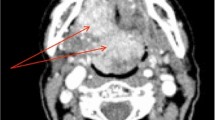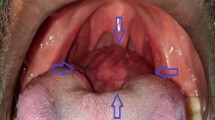Abstract
Lingual thyroid is the result of a defective migration of the thyroid anlage occurring between the 3rd and 7th week of gestation. Whereas mutations in the transcription factor-2 (TTF-2) and PAX8 and in the TSH receptor genes (TSH-R) have been reported in a minority of patients with thyroid dysgenesis, the etiopathogeny of the majority of cases, and in particular of thyroid ectopy, remains unclear. The majority of patients with thyroid ectopy are asymptomatic, but obstructive symptoms as well as hypothyroidism have been observed. Hyperthyroidism is an exceptionally rare finding. To our knowledge, only 2 cases have been reported in the literature to date. Herein, we describe an unusual case of thyrotoxicosis related to a nodular lesion in a lingual thyroid. Treatment consisted in restoration of a euthyroid state with thionamide followed by surgical removal of the ectopic gland. The underlying molecular cause of the ectopic lingual thyroid and the toxic adenoma in this case could not be identified. We speculate that abnormally early differentiation of the thyroid gland could interfere with the migration process, a hypothesis yet to be confirmed.
Similar content being viewed by others
References
Dossing H., Jorgensen K.E., Oster-Jorgensen E., Krogdahl A., Hegedüs L. Recurrent pregnancy-related upper airway obstruction caused by intratracheal ectopic thyroid tissue. Thyroid 1999, 9: 955–958.
Basaria S., Cooper D. Grave’s disease and recurrent ectopic thyroid tissue. Thyroid 1999, 9: 1261–1264.
Noyek A.M., Friedberg J. Thyroglossal duct and ectopic thyroid disorders. Otolaryngol. Clin. North Am. 1981, 14: 187–201.
Pollice L., Caruso G. Struma cordis. Ectopic thyroid goiter in the right ventricle. Arch. Pathol. Lab. Med. 1986, 110: 452–453.
Roth L.M. Inclusions of non-neoplastic thyroid tissue within cervical lymph nodes. Cancer 1965, 18: 105–111.
Neinas F.W., Gorman C.A., Devine K.D., Woolner L.B. Lingual thyroid: clinical characteristics of 15 cases. Ann. Intern. Med. 1973, 79: 205–210.
Devos H., Rodd C., Gagne N., Laframboise R., Van Vliet G. A search for the possible molecular mechanisms of thyroid dysgenesis: Sex ratios and associated malformations. J. Clin. Endocrinol. Metab. 1999, 84: 2502–2506.
Arancibia P., Veliz J., Barria M., Pineda G. Lingual thyroid: report of three cases. Thyroid 1998, 8: 1055–1057.
Maurice N., Makeieff M., Delol J., et al. La thyroïde ectopique linguale à propos de trois cas. Ann. Otolaryngol. Chir. Cervicofac. 1995, 112: 399–405.
Macchia P.E., Mattei M.G., Lapi P., Fenzi G., Di Lauro R. Cloning, chromosomal localization and identification of polymorphism in the human thyroid transcription factor 2 gene (TITF2). Biochimie 1999, 81: 433–440.
De Felice M., Ovitt C., Biffali E., et al. A mouse model for hereditary thyroid dysgenesis and cleft palate. Nat. Genet. 1998, 19: 395–398.
Clifton-Bligh R.J., Wentworth J.M., Heinz P., et al. Mutation of the gene encoding human TTF-2 associated with thyroid agenesis, cleft palate and choanal atresia. Nat. Genet. 1998, 19: 399–401.
Gagne N., Parma J., Deal C., Vassart G., Van Vliet G. Apparent congenital athyreosis contrasting with normal plasma thyroglobulin levels and associated with inactivating mutations in the thyrotropin receptor gene: Are athyreosis and ectopic thyroid distinct entities? J. Clin. Endocrinol. Metab. 1998, 83: 1771–1775.
Abramowicz M.J., Duprez L., Parma J., Vassart G., Heinrichs C. Familial congenital hypothyroidism due to inactivating mutation of the thyrotropin receptor causing profound hypoplasia of the thyroid gland. J. Clin. Invest. 1997, 99: 3018–3024.
Macchia P.E., Lapi P., Krude H., et al. Pax8 mutations associated with congenital hypothyroidism caused by thyroid dysgenesis. Nat. Genet. 1998, 19: 83–86.
Lapi P., Macchia P.E., Chiovato L., et al. Mutations in the gene encoding thyroid transcription factor -1 (TTF-1) are not a frequent cause of congenital hypothyroidism with thyroid dysgenesis. Thyroid 1997, 7: 383–387.
Perna M.G., Civitareale D., De Filippis V., et al. Absence of mutations in the gene encoding thyroid transcription factor-1 (TTF-1) in patients with thyroid dysgenesis. Thyroid 1997, 7: 377–381.
Koch C.A., Picken C., Clement S.C., Azumi N., Sarlis N.J. Ectopic lingual thyroid: An otolaryngologic emergency beyond childhood. Thyroid 2000, 10: 511–514.
Chanin L.R., Greenberg L.M. Pediatric upper airway obstruction due to ectopic thyroid: classification and case reports. Laryngoscope 1988, 98: 422–427.
Guerin N., Urtasun A., Chauveau E., et al. Thyroïde linguale et kyste thyreo-glosse basi-lingual. A propos de deux cas. Rev. Laryngol. Otol. Rhinol. 1997, 118: 183–188.
Turgut S., Murat Ozcan K., Celikkanat S., Katirci H., Ozdem C. Diagnostic et traitement de la thyroïde linguale: revue de la littérature. Rev. Laryngol. Otol. Rhinol. 1997, 118: 189–192.
Kamat M.R., Kulkarni J.R., Desai P.B., Jussawalla D.J. Lingual thyroid: A review of 12 cases. Br. J. Surg. 1979, 66: 537–539.
Kaplan M., Kauli R., Lubin E., Grunebaum M., Laron Z. Ectopic thyroid gland. A clinical study of 30 children and review. J. Pediatr. 1978, 92: 205–209.
Kuehn P.G., Newell R.C., Reed J.F. Exophtalmos in a woman with lingual, subhyoid and lateral lobe thyroid glands. N. Engl. J. Med. 1966, 274: 652–654.
Azzam A., Nitunga N., Baulieu J.L., et al. Ectopie thyroïdienne et maladie de Basedow. Presse Med. 1988, 17: 383–385.
Simkin P.H., Ramierz L.A., Zweizig S.L., et al. Monomorphic teratoma of the ovary: a rare cause of triiodothyronine toxicosis. Thyroid 1999, 9: 949–954.
Grüters A., Schöneberg T., Biebermann H., et al. Clinical Case Seminar: Severe congenital hyperthyroidism caused by a germ-line neo mutation in the extracellular portion of the thyrotropin receptor. J. Clin. Endocrinol. Metab. 1998, 83: 1431–1436.
Duprez L., Parma J., Van Sande J., et al. Germline mutations in the thyrotropin receptor gene cause non-autoimmune autosomal dominant hyperthyroidism. Nat. Genet. 1994, 7: 396–401.
Tonacchera M., Van Sande J., Cetani F., et al. Functional characteristics of three new germline mutations of the thyrotropin receptor gene causing autosomal dominant toxic thyroid hyperplasia. J. Clin. Endocrinol. Metab. 1996, 81: 547–554.
Kopp P., Jameson L., Roe T. Congenital nonautoimmune hyperthyroidism in a nonidentical twin caused by a sporadic germline mutation in the thyrotropin receptor gene. Thyroid 1997, 7: 765–770.
Esapa C.T., Duprez L., Ludgate M., et al. A novel thyrotropin receptor mutation in a infant with severe thyrotoxicosis. Thyroid 1999, 9: 1005–1010.
Van Sande J., Parma J., Tonacchera M., et al. Somatic and germline mutations of the TSH receptor gene in thyroid diseases. J. Clin. Endocrinol. Metab. 1995, 80: 2577–2585.
Führer D., Kubisch C., Scheibler U., et al. The extracellular thyrotropin receptor domain is not a major candidate for mutations in toxic thyroid nodules. Thyroid 1998, 8: 997–1001.
Duprez L., Parma J., Van Sande J., et al. Pathology of the TSH receptor. J. Pediatr. Endocrinol. Metab. 1999, 12: 295–302.
Parma J., Van Sande J., Swillens S., et al. Somatic mutations causing constitutive activity of the thyrotropin receptor are the major cause of hyperfunctioning thyroid adenomas: identification of additional mutations activating both the cyclic adenosine 3′,5′-monophosphate and inositol phosphate-Ca2+ cascades. Mol. Endocrinol. 1995, 9: 725–733.
Takeshita M., Nagayama Y., Yokoyama N., et al. Rarity of oncogenic mutations in the thyrotropin receptor of autonomously functioning thyroid nodules in Japan. J. Clin. Endocrinol. Metab. 1995, 80: 2607–2611.
Biebermann H., Liesenkotter K.P., Emeis M., Oblanden M., Grüters A. Severe congenital hypothyroidism due to a homozygous mutation of the beta TSH gene. Pediatr. Res. 1999, 46: 170–173.
Doeker B.M., Pfaffle R.W., Pohlenz J., Andler W. Congenital central hypothyroidism due to a homozygous mutation in the thyrotropin beta-subunit gene follows an autosomal recessive inheritance. J. Clin. Endocrinol. Metab. 1998, 83: 1762–1765.
Medeiros-Neto G., Herodotou D.T., Rajan S., et al. A circulating, biologically inactive thyrotropin caused by a mutation in the beta subunit gene. J. Clin. Invest. 1996, 97: 1250–1256.
Author information
Authors and Affiliations
Corresponding author
Rights and permissions
About this article
Cite this article
Abdallah-Matta, M.P., Dubarry, P.H., Pessey, J.J. et al. Lingual thyroid and hyperthyroidism: A new case and review of the literature. J Endocrinol Invest 25, 264–267 (2002). https://doi.org/10.1007/BF03344002
Accepted:
Published:
Issue Date:
DOI: https://doi.org/10.1007/BF03344002




